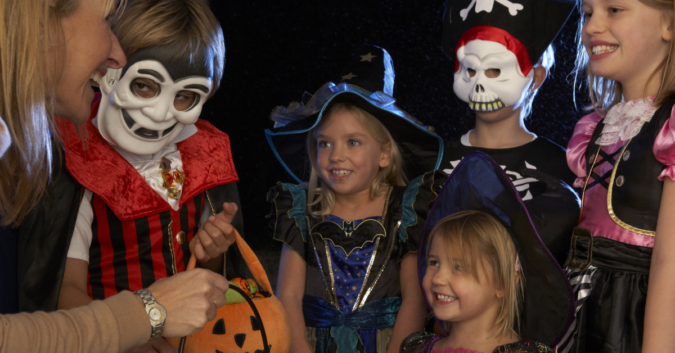With all of the sugary candy, scary stories, and imaginative costumes, it’s no wonder Halloween is a favorite holiday among millions of American children. For some children with disabilities, however, difficulties can arise that can make Halloween a bit more challenging and/or frustrating.
The U.S. Centers for Disease Control and Prevention (CDC) estimates that roughly 17% of children aged 3-17-years-old have a developmental disability of some kind. Chief among these disabilities is cerebral palsy, a type of birth injury and the most common motor-function disability in childhood.
Luckily, there are many things that adults can do to prepare a Halloween trick-or-treating experience that’s more inclusive for all children. Below are some of our favorites.
Move the Treat Bowl Closer to Street-Level
It’s understandable that during a pandemic, some homes may choose to offer a no-contact trick-or-treating experience for children by simply placing a treat bowl outside of their door instead of handing treats directly to trick-or-treaters.
Similarly, shifting your treat bowl to the bottom of any doorsteps and/or closer to the sidewalk is a simple way to make trick-or-treating easier and more accessible for children with wheelchairs and/or children with common motor-function disabilities like cerebral palsy who may have trouble climbing stairs.
Downgrade the Spookiness, Upgrade the Fun
While Halloween is without a doubt a “spooky” American tradition, research has shown that roughly 1 out of every 8 children in the United States suffers from an anxiety disorder. Anxiety disorders can impact every aspect of a child’s life.
This year, consider that not every child wants to be or feel scared — even on Halloween! Some children with anxiety disorders may become fearful if there is too much spookiness and be unable to participate in trick-or-treating as a result.
So, save the strobe lights, fog machines, noise/sound generators, and especially creepy decorations and masks for adult Halloween parties. More important is simply making sure your home is well-lit and accessible for children of all ability levels.
Be Patient and Understanding
Not every child is verbal — in fact, many children with autism spectrum disorder (ASD) find communicating especially difficult.
Moreover, non-verbal or non-speaking children may not be able to say “trick-or-treat” or “thank you.” Be sure not to pressure children into giving a verbal response, and be especially sensitive toward children who do not give the expected social responses many associate with Halloween.
In addition, children with speech and/or hearing issues will appreciate being able to see your face and mouth move while you are speaking.
Think Beyond the Sweets
Hand-in-hand with blue pumpkins, which support children with ASD (more below), teal-colored pumpkins have come to represent children with food allergies, a movement credited to Food Allergy Research and Education (FARE). FARE’s Teal Pumpkin Project helped inspire other movements, such as the now-popular blue pumpkins (ASD) and purple pumpkins (epilepsy).
Food allergies affect 1 in every 13 children in the United States, according to the CDC. Unfortunately, a majority of popular American candies contain nuts, eggs, milk, soy, or wheat, which are some of the most common allergens among children.
To join the Teal Pumpkin Project or to simply support children with food allergies, consider giving out non-sweets on Halloween, including fun things like:
- Bookmarks
- Crayons
- Glow rings or bracelets
- Keychains
- Markers
- Stickers
- Spider rings
- Vampire teeth
- Toys, including:
- Bouncy balls
- Bubbles
- Kazoos
- Slinkies
- Squeeze toys
- Stampers
If you choose to join the Teal Pumpkin Project, consider adding your home or residence to the Teal Pumpkin Project map, which can be found on the organization’s website alongside additional information about the holiday movement.
Embrace the Blue Pumpkin Movement
If you’re like many American adults, you may have seen blue pumpkins on Halloween in recent years and wondered what they signify. What began as a social media movement has turned into a full-fledged awareness campaign now supported by Autism Speaks and the Autism Society of America. Blue pumpkins aim to offer support to the 1 in 54 children who are on the autism spectrum.
Trick-or-treaters who carry blue-colored pumpkins with them may be signaling to adults that they are on the autism spectrum. Autism spectrum disorder (ASD) may present unique challenges for children on Halloween night, such as difficulty with speech (including non-verbal children) or certain interactions.
By displaying blue-colored pumpkins at your residence on Halloween night, you are saying that you’ve taken time to familiarize yourself with some of the common issues children with ASD experience and that you are supporting them on this very special night.
Making Halloween Special for Children of All Abilities
When October rolls around, many children spend hours thinking up creative Halloween costume ideas and daydreaming about all of the treats they’ll soon be able to collect and enjoy — but not every child finds Halloween to be an easy holiday, and that can be especially true for children with disabilities.
However you decide to go about preparing your home for Halloween night, remember the key is to try to make the evening fun and special for all children who will be trick-or-treating — something that they can remember for years to come.
